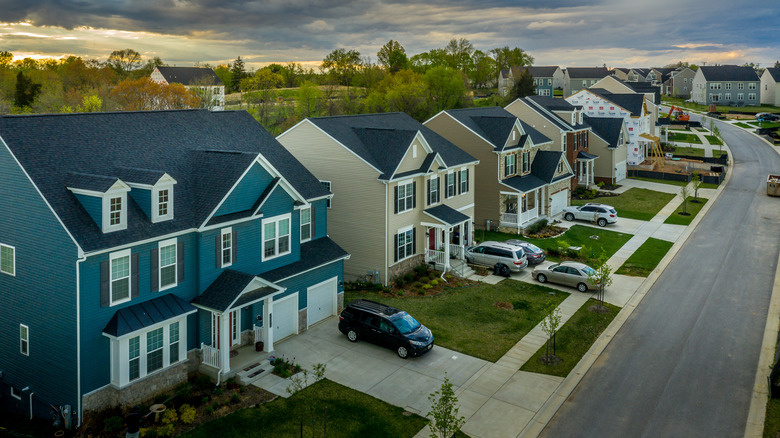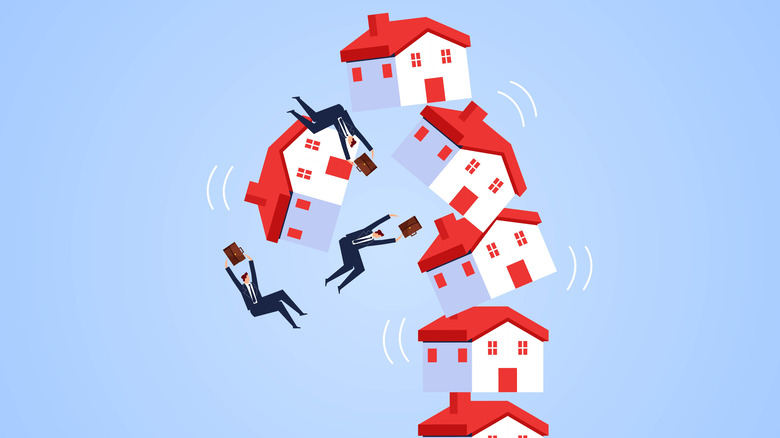Prices In These Housing Markets Are Projected To Fall By Over 15%
Housing in the U.S. has been on a rollercoaster ride in recent years. According to Reuters, although average house prices have doubled since 2012, they went up by 40% in the last two years, fueled by the unprecedented conditions of the COVID-19 pandemic.
As well as the search for more space that drove people to move in recent years, the market was buoyed by monetary factors that saw the average 30-year mortgage interest rate plummet to its lowest-ever level of 2.65% in January 2021 (via CNN). In 2022, mortgage rates have been rising rapidly as the Federal Reserve hiked its base interest rates to fight against inflation. Today's rates are more than double last year's all-time low, increasing nearly 400 basis points in 10 months from 3.22% in January to 7.08% in October. However, according to The Mortgage Reports, this is still below the historical average of 7.76% that we get from looking at rates since 1971.
So, with prices on average 40% higher than just two years ago and the cost of borrowing money on the rise as well, many potential homebuyers are finding themselves priced out of the market altogether or are discovering that the mortgage they were eligible for in spring is no longer a viable option. This phenomenon is, according to Fortune, called pressurized affordability. Overheated housing markets across the nation are on course for a price correction in 2023, so keep reading to find out which areas will be worst affected and why.
Averages never tell the whole story
Every house has its own unique context, each owner and buyer will have their own areas of strength and weakness, and some places are just impervious to trends and time. Unfortunately, the national housing market is aggregated from millions of these individual transactions, and it misses a lot of the important details.
One such important detail is that within a booming national market, there are some areas where house prices spike much higher than is sustainable, while others rise in line with what is reasonable for the economic fundamentals of that region. According to Yahoo! Finance, rating agency Moody's assesses local housing markets each quarter to check if the prices are changing as they would expect based on economic theory or if something else might be at work. These reports don't necessarily explain why prices are too high or low in an area, but once average values in a market are 25% higher than expected, Moody's labels that district as significantly overvalued. As a result, 210 of the 413 largest markets in the U.S. are classed as significantly overvalued in 2022.
According to Fortune, these markets are the areas at the highest risk of a sharp decline in house prices, especially if conditions are conducive to a drop, as they are now. However, many popular markets aren't overvalued at all, with Newsweek reporting that house prices in states like Maryland, New York, and Illinois appear well-placed to weather the coming storms.
Where are house prices expected to fall the most in 2023?
The housing market in Boise, Idaho, boomed recently, culminating in a huge 77% overvaluation (via Fortune). As rates began to rise in mid-2022, things started to change quickly. Per Benzinga, 70% of listings in Boise reduced their selling price in July; and that says nothing of the new listings that were put on at lower prices. Home values dropped 5.3% in the area between May and August 2022, but the total fall from peak to trough is predicted to be a whopping 21.8% (via Fortune).
It is very important to note that the overvaluation percentage is not the amount prices are expected to drop! Analysts are calling this a correction, not a crash. The reason is, according to Forbes, that the housing supply isn't enough for the level of demand, so though there will be a fall in house prices, there should be a floor waiting to break that fall. In total, some 49 markets are predicted by Moody's to see drops of over 15%, peak to trough.
Some other notable, large urban markets most poised for a fall include Flagstaff and Phoenix, Arizona, predicted to see 19.1% and 16.4% drops, respectively. The Michigan city of Grand Rapids is facing a slowdown of 18.6%, while nearby Ann Arbor and Lansing-East Lansing are both looking at 15.6% slowdowns. Finally, Music City, Nashville, Tennessee, and Knoxville, Tennessee, home of the Volunteers, make the list with 18.3% and 16.4% each.


